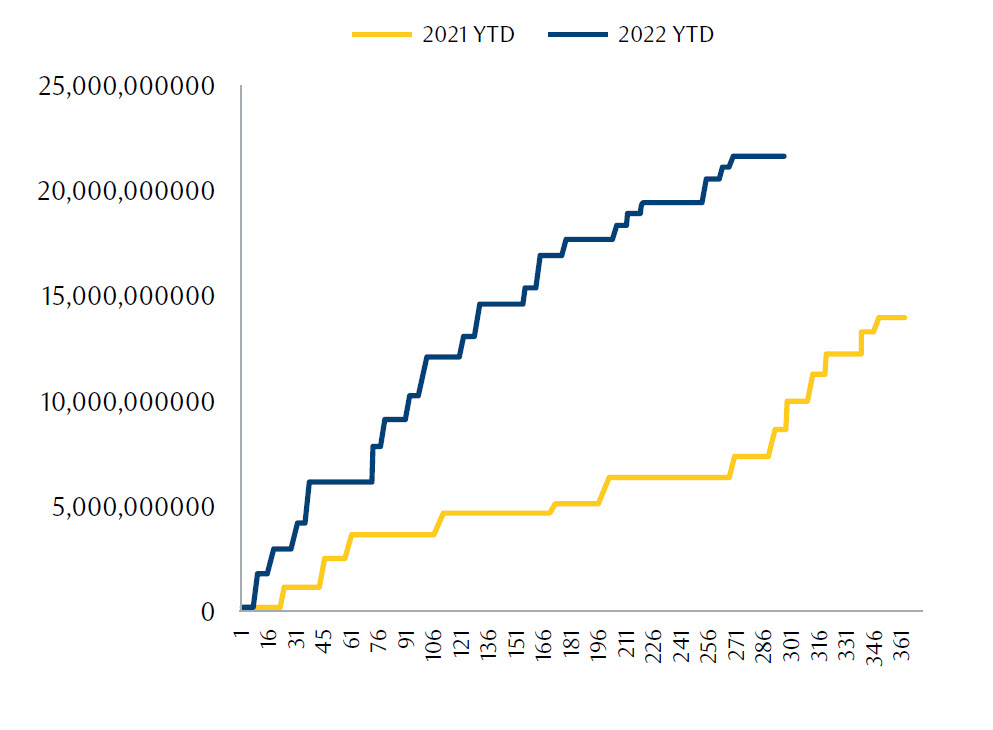Fixed income and other risk assets have come under pressure in 2022, following the global battle against inflation and the resultant significant tightening of financial conditions. This has been combined with several other factors to put pressure on risk asset valuations, including the effects of the war in Ukraine on natural resources and, more recently, a glut of supply following liquidations by asset managers on behalf of UK defined benefit pension schemes.
In some markets, valuations have become dislocated from fundamental risks. The key to investors taking advantage of dislocations is to target those that are more technical, rather than fundamental in nature. We believe that Securitized Credit markets have dislocated more than other fixed income asset classes and thus offer a very attractive opportunity. On top of attractive absolute and relative valuations, Securitized Credit is fundamentally robust and offers significant protection from defaults – preservation of capital in today’s environment is also of utmost importance.
In this report, we dive deeper into the relative value of Securitized Credit versus other asset types to help identify the most attractive dislocations.
CLOs
A good place to start is with Collateralised Loan Obligations (“CLOs”) – these are securitizations backed by corporate loans. As the underlying collateral are corporate borrowers, this makes direct comparison to corporate bonds on a like-for-like basis possible, given the similar underlying risk factors. The first chart shows the credit spread on offer in BB-rated CLO bonds compared to BB-rated corporate bonds in Europe. The basis between the two is much wider than in less volatile periods and has dislocated close to Covid-era levels.
By comparison, in the second chart, the same analysis in the US shows the dislocation is much less meaningful i.e. European CLOs are more dislocated than their US counterparts and will outperform if spreads normalise. Part of the reason for this difference is the higher fundamental risks faced by European corporates. However, we believe that prices have overshot fundamental concerns, given the embedded level of protection from defaults in CLOs, and that numerous technical factors are dominating price action. These include huge oversupply following liquidations from UK pension funds and the changing buyer base for European Securitized Credit. Finally, on CLOs, it is also important to note that this analysis can be replicated for different rating bands and the outcome is similar – European CLO valuations are dislocated from fundamentals across the capital structure.
Chart 1: Credit spread on offer in BB-rated CLO bonds compared to BB-rated corporate bonds in Europe

Source: Wells Fargo, Bloomberg.
Chart 2: Credit spread on offer in BB-rated CLO bonds compared to BB-rated corporate bonds in the US

Source: Wells Fargo, Bloomberg.
US Agency Mortgage CRT
CLOs are not the only sector of Securitized Credit markets that currently offer compelling value to investors. One other sector is US Agency Mortgage Credit Risk Transfer (“CRT”) – these are securitizations issued by Fannie Mae and Freddie Mac and backed by prime mortgages in the US. The third chart below shows how valuations in this asset class have moved relative to corporate spreads at the BBB-rated level.
It’s always important to ask why valuations are dislocated. In this case – supply, a technical factor, in the early part of the year overwhelmed markets as Fannie Mae and Freddie Mac worked through huge mortgage volumes which originated in 2021, as can be seen in our fourth chart. On top of this, the uncertainty of how the housing market would handle substantially higher mortgage rates fed into the volatility. This is a risk that can be mitigated by concentrating investments in more seasoned mortgages that have embedded house price appreciation, the fact that US mortgage underwriting has been high quality and that mortgages are fixed rate i.e. the existing cohort does not come under pressure purely from an increase in current mortgage rates. Going forward, mortgage issuance is expected to decline significantly due to higher rates and, as such, supply will also come down dramatically.
Chart 3: Basis between BBB CRT new issue and BBB Corps

Source: Goldman Sachs.
Chart 4: CRT New Issue Supply

Source: Goldman Sachs.
UK RMBS
Our final example is UK RMBS. AA-rated bonds are extremely well protected from increased fundamental risks, yet all the factors discussed above and the current uncertainty the UK faces has led these bonds to fall dramatically in price. This can be seen relative to UK corporate bonds in our fifth chart. In order for a AA-rated bond to be impaired and not return full principal, then cumulative losses need to reach around 20% in the underlying pool of mortgages – when this is compared to ~4% losses witnessed during the GFC (a period where mortgage underwriting was much worse quality), one can see that these bonds are extremely well protected fundamentally and that the change in valuations is driven by technical factors.
Chart 5: Basis between UK NC AA and UK AA corps

Source: Citi
In conclusion, dislocations are currently prevalent across the Securitized Credit asset class – different asset types, parts of the capital structure and geographies. These dislocations allow investors an excellent entry point on a relative and absolute basis, with the potential to generate outsized, high quality, risk-adjusted returns.
